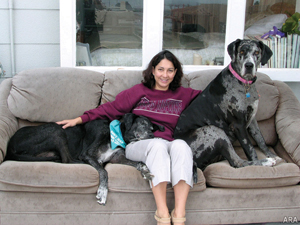 When Alysa Brennan of Hermosa Beach, Calif., discovered one of her Great Danes had cancer, she was faced with a difficult decision, but she felt fortunate that her veterinarian, Dr. Alice Villalobos, was familiar with veterinary hospice care and introduced her to the concept.
When Alysa Brennan of Hermosa Beach, Calif., discovered one of her Great Danes had cancer, she was faced with a difficult decision, but she felt fortunate that her veterinarian, Dr. Alice Villalobos, was familiar with veterinary hospice care and introduced her to the concept.
“I knew Blake, my dog, was old enough that I didn’t want to go through any heroic measures to try to keep him alive. I wasn’t going to consider chemotherapy. Dr. Villalobos explained that we could keep him as pain free as possible until the end,” Brennan explains.
“He passed very peacefully thanks to Alice being there with me,” she continues. “He died literally in my arms. I had moved an old couch outside for him, so he could sleep on it. One night he came in and was looking at me in a strange way. I laid down with him, and his breathing was very labored so I called Alice. It was his end.”
Hospice care – physical and physiological care for the well-being of the terminally ill – has a long history in the United States. But hospice care for animals is a very new concept. Dr. Villalobos treated Blake’s end-of-life discomfort with pain medications and homeopathic medicines.
Veterinary hospice is a philosophy that is really in its infancy. In 2000, the movement gained national attention at the annual convention of the American Veterinary Medical Association (AVMA) where Villalobos spoke on hospice care. The first international symposium wasn’t held until March 2008 at the University of California, Davis, and the International Association for Animal Hospice and Palliative Care (IAAHPC) is currently being established.
Dr. Amir Shana, owner of the
Compassionate Care Veterinary Clinic in Chicago, has been offering hospice care to animals for well over a decade. Shana provides house calls for patients who are too sick to make it into his office, and also runs a hospice facility where animals can be boarded. About half of his practice is in pet hospice services.
“Hospice is a philosophy of care; it is also a program of care and in certain cases it is an actual place where patients are being cared for,” Dr. Shana explains.
For Dr. Villalobos, the new movement really recognizes something that has been happening for many decades. “Veterinarians have always offered care to animals at the end of life,” explains Villalobos. “Until now, it has not been a recognized philosophy, and it hasn’t had a name.”
Dr. Villalobos says that one of the most important aspects of this new movement is that it’s seen as a philosophy that is accessible to all veterinarians so they can better serve their patients. And it doesn’t require that pet owners give up hope, she adds. Pet hospice care can be incorporated with measures taken to attempt to save the pet’s life. It means simply that the animal’s needs are taken care of with pain control and other efforts to reduce suffering.
Dr. Villalobos says that one of the biggest hurdles in veterinary hospice care is dealing with the shock that owners feel when discovering that their pet has a condition that may precipitate end-of-life care.
“A decade goes by and it is quick for us, but it is the lifespan of a pet. It takes a lot of compassion to help people to understand it. It sneaks up on them. We have people who are in shock that their four-footed, beloved companion is now geriatric,” Dr. Villalobos says. “The philosophy of hospice is letting the pet owner know the pet is dying.”
The Second International Symposium on Veterinary Hospice Care will be held over Labor Day weekend on the campus of University of California, Davis. This new group, which recognizes veterinarians, veterinary technicians, social workers, psychologists, ethicists, and clergy, has a great deal of work to do setting standards for this new field. For example, members will begin establishing protocols and guidelines for pain control, the place of euthanasia, and quality of life. The field is so new that attendees will even be charged with the task of defining pet hospice care. Visit www.cevs.ucdavis.edu/confreg/?confid=442 for more information.









